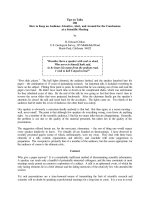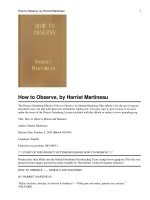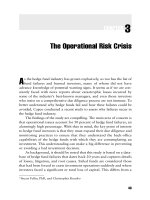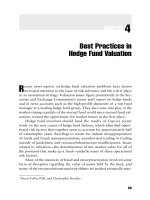hedges on hedge funds how to successfully analyze and select an investment
Bạn đang xem bản rút gọn của tài liệu. Xem và tải ngay bản đầy đủ của tài liệu tại đây (2.06 MB, 258 trang )
TeAM
YYePG
Digitally signed by TeAM YYePG
DN: cn=TeAM YYePG, c=US,
o=TeAM YYePG, ou=TeAM
YYePG, email=
Reason: I attest to the accuracy
and integrity of this document
Date: 2005.07.06 09:17:28 +08'00'
Hedges on
Hedge Funds
ffirs_hedges.qxd 8/30/04 11:53 AM Page i
John Wiley & Sons
Founded in 1807, John Wiley & Sons is the oldest independent publishing com-
pany in the United States. With offices in North America, Europe, Australia,
and Asia, Wiley is globally committed to developing and marketing print and
electronic products and services for our customers’ professional and personal
knowledge and understanding.
The Wiley Finance series contains books written specifically for finance
and investment professionals as well as sophisticated individual investors and
their financial advisors.
Book topics range from portfolio management to e-commerce, risk man-
agement, financial engineering, valuation and financial instrument analysis, as
well as much more.
For a list of available titles, visit our Web site at www.WileyFinance.com.
ffirs_hedges.qxd 8/30/04 11:53 AM Page ii
Hedges on
Hedge Funds
How to Successfully Analyze
and Select an Investment
JAMES R. HEDGES IV
John Wiley & Sons, Inc.
ffirs_hedges.qxd 8/30/04 11:53 AM Page iii
Copyright © 2005 by James R. Hedges IV. All rights reserved.
Published by John Wiley & Sons, Inc., Hoboken, New Jersey.
Published simultaneously in Canada.
No part of this publication may be reproduced, stored in a retrieval system, or transmitted
in any form or by any means, electronic, mechanical, photocopying, recording, scanning,
or otherwise, except as permitted under Section 107 or 108 of the 1976 United States
Copyright Act, without either the prior written permission of the Publisher, or authorization
through payment of the appropriate per-copy fee to the Copyright Clearance Center, Inc.,
222 Rosewood Drive, Danvers, MA 01923, 978-750-8400, fax 978-646-8600, or on the
web at www.copyright.com. Requests to the Publisher for permission should be addressed
to the Permissions Department, John Wiley & Sons, Inc., 111 River Street, Hoboken, NJ
07030, 201-748-6011, fax 201-748-6008.
LJH Global Investments, LLC provides advisory services in the areas of hedge funds and
alternative investments. Not all products and services are available in all locations, and not
all investments are suitable for all investors.
Any discussion of investment and investment strategy of funds (including current invest-
ment themes, research and investments processes and portfolio characteristics) represents
the views of LJH Global Investments, LLC as reported by the publication, at the time of
publication. All expressions of opinion included herein are subject to change without
notice and are not intended to be a guarantee of future events.
This book is supplied for information only and does not constitute a solicitation to buy or
sell securities. Opinions expressed herein may differ from the opinions expressed by other
businesses and activities of LJH Global Investments, LLC. Although information and opin-
ions in this article have been obtained from sources believed to be reliable, LJH does not
warrant the accuracy or completeness and accepts no liability for any direct or consequen-
tial losses arising from its use.
Limit of Liability/Disclaimer of Warranty: While the publisher and author have used their
best efforts in preparing this book, they make no representations or warranties with respect
to the accuracy or completeness of the contents of this book and specifically disclaim any
implied warranties of merchantability or fitness for a particular purpose. No warranty
may be created or extended by sales representatives or written sales materials. The advice
and strategies contained herein may not be suitable for your situation. You should consult
with a professional where appropriate. Neither the publisher nor author shall be liable for
any loss of profit or any other commercial damages, including but not limited to special,
incidental, consequential, or other damages.
For general information on our other products and services, or technical support, please
contact our Customer Care Department within the United States at 800-762-2974,
outside the United States at 317-572-3993 or fax 317-572-4002.
Wiley also publishes its books in a variety of electronic formats. Some content that
appears in print may not be available in electronic books.
For more information about Wiley products, visit our web site at www.wiley.com.
Library of Congress Cataloging-in-Publication Data
Hedges IV, James R., 1967–.
Hedges on hedge funds : how to successfully analyze and select an investment /
James Hedges.
p. cm.
Includes index.
ISBN 0-471-62510-8 (cloth)
1. Hedge funds. I. Title.
HD4530.H3884 2005
332.64′5—dc22
2004011591
Printed in the United States of America.
10 9 8 7 6 5 4 3 2 1
ffirs_hedges.qxd 8/30/04 11:53 AM Page iv
To Lundy, Evans, and Malone
ffirs_hedges.qxd 8/30/04 11:53 AM Page v
ffirs_hedges.qxd 8/30/04 11:53 AM Page vi
Contents
Foreword ix
Preface xiii
Acknowledgments xxi
CHAPTER 1
The Hedge Fund Alternative 1
CHAPTER 2
Cutting through the Black Box: Transparency and Disclosure 23
CHAPTER 3
The Operational Risk Crisis 43
CHAPTER 4
Best Practices in Hedge Fund Valuation 53
CHAPTER 5
Does Size Matter? 65
CHAPTER 6
Directional Investing through Global Macros and Managed Futures 75
CHAPTER 7
Profiting from the Corporate Life Cycle 93
vii
ftoc_hedges.qxd 9/1/04 2:31 PM Page vii
CHAPTER 8
Evaluating Arbitrage and Relative Value Strategies 111
CHAPTER 9
The Time Is Now for Equity Market Neutral 133
CHAPTER 10
Long-Short Strategies in the Technology Sector 143
CHAPTER 11
The Expansion of European Hedge Funds 151
CHAPTER 12
The Dynamic World of Asian Hedge Funds 167
CHAPTER 13
Hedge Fund Indices: In Search of a Benchmark 187
GLOSSARY 199
ABOUT THE AUTHORS 217
INDEX 221
viii CONTENTS
ftoc_hedges.qxd 9/1/04 2:31 PM Page viii
Foreword
D
oes the world need another book on hedge funds? For that matter,
does the world need another hedge fund? More fundamentally, does
the world need another equity, convertible bond, straight bond, option,
foreign exchange contract, swaption, or any of the myriad securities
that underlie all hedge fund strategies? The per se answer to all of these
questions is no, but the practical reality is that we will have more—
much more—of all of the above. More books, more funds, more exotic
combinations of securities.
Why? Because it is in the nature of markets to innovate. Because the
historical record of risk-adjusted returns of the various hedge fund cat-
egories is compelling. Because the barriers to hedge fund creation are
nearly nonexistent. Because there is a tidal wave of capital that wants
better returns with less risk; pension funds, endowments, individuals,
and even nations that have not yet supped at the hedge fund trough.
Will the marginal investor reap the risk-adjusted returns that they
envision? Maybe. Will the incremental hedge fund operator succeed in
providing those returns and therefore prosper? Some. Will various hedge
fund strategies tend toward saturation—both by investors and praction-
ers—thereby driving down incremental benefits? Definitely!
As the hedge fund industry enters early maturity, investors and fund
managers need to look beyond the immediate imperative of producing
attractive returns and contemplate the risks and opportunities in a longer
time frame. We should be concerned not only with the durabilty of our
ix
fbetw_hedges.qxd 8/26/04 3:10 PM Page ix
strategies, but also such issues as the scalability of individual firms, strate-
gies, and the industry; adequate disclosure and communication (trans-
parency); the evolving regulatory environment; organizational behavior
and health; and terminal value—both in terms of product offering and
business economics. We need to think about the “going concern” attrib-
utes of individual funds and the industry.
As chairman of Cumberland Associates LLC, one of the longest run-
ning hedge funds on the planet, these long-term concerns are at least as
important as the quotidian requirements of identifying undervalued and
overvalued securities through a well-honed research process. I need to
attend to the psychological and economic well being of my fellow mem-
bers and staff, communicate with investors and prospects, cultivate the
human and process capital that will be required for succession of own-
ership and management of our firm, and above all, make sure that we
stay focused yet adaptable.
Central to the process of staying competent and adaptable is what I
think of as a willingness to ask “dumb questions”; I have built a career
on dumb questions asked of thousands of company managements, my
colleagues, myself. What I am really talking about is a willingness and
even a need to return constantly to fundamental issues as the context of
an individual, a company, an industry, or the world evolves. My allies in
this process are colleagues, both internal and external, who believe that
while they know a thing or two, realize that the shelf life of an insight
gets shorter every day.
For the past fifteen years, one of my most valued correspondents in
this professional dialectic has been Jim Hedges. I have known him as an
analyst, a client, and the proprietor of his own successful advisory and
fund of fund business. Jim’s hallmarks are the courage, curiosity, and con-
fidence to think broadly, probe deeply, synthesize, and express suc-
cinctly. I have always prized his input, even when he made me squirm!
Now you too can experience the pointy end of Jim’s intellect and
experience. In this book, Jim has posed the “dumb” and sophisticated
questions that all investors and investment managers should be asking
themselves and has set forth his thoughts for our benefit. But this work
is more than a compilation of his own observations and opinions; he has
x FOREWORD
fbetw_hedges.qxd 8/26/04 3:10 PM Page x
Foreword xi
called upon commentators and practitioners who have earned his respect
to broaden and deepen this offering.
The utility of this book to the hedge fund investor, particulary the
novice, is readily apparent. I happen to think that it should be required
reading for the hedge fund professional as well. One of the salient
weaknesses of the hedge fund industry is the predominance of the “sole-
proprietor” model, in which one personality dominates the deployment
of capital. This structure inherently lacks strong checks and balances. If
this sounds like your firm you should read this book.
Investors need to recognize that the combination of low barriers to
entry and lucrative returns has attracted thousands of new hedge fund
proprietors. Investors have exhibited a fairly marked tendency to try to
discover “hot” new managers; have overemphasized facile quantitative
measures of risk; have underemphasized qualitative, ethical, and struc-
tural elements of managers; and have unrealistically projected short or
nonexistent performance records. In so doing, they have often incurred
much greater risk and/or disappointing returns than they expected.
The explosion in new hedge fund capital is coinciding with broad-
ening distribution and access. The offerings will reach marginally less
sophisticated investors—be they institutions or individuals—as the
overall probability of gaining “excess” returns diminishes for the hedge
fund universe as a whole. The rate of innovation, number of vehicles,
and risks in the hedge fund world will proliferate at an ever faster pace.
It is incumbent upon investors to educate and protect themselves; this
book is an excellent place to start or revew that education.
Bruce G. Wilcox, Chairman
Management Committee,
Cumberland Associates LLC
fbetw_hedges.qxd 8/26/04 3:10 PM Page xi
fbetw_hedges.qxd 8/26/04 3:10 PM Page xii
Preface
T
he bull market of the late 1990s created significant wealth, yet subse-
quent bear market years diminished many investor portfolios. Natu-
rally, investors find the concept of shrinking assets to be unacceptable
and seek ways to generate greater wealth. Emulating the best practices
of the world’s most successful investors has led to increasing “retailiza-
tion” of hedge funds, funds that formerly were available only to the
world’s richest individuals.
Although hedge funds are not yet sold at the corner bank branch or
ATM, that is not beyond the realm of possibility. The industry contin-
ues to experience exponential growth with studies predicting $4 trillion
in hedge fund assets by 2010—up from close to $800 billion in 2004.
(See Figure P.1.) Because hedge fund investing is based on a dynamic
approach that is uncorrelated to general market conditions, its appeal
continues to expand and more investors than ever seek ways to capital-
ize on the hedge fund opportunity. As a result, there are more hedge funds
around than ever, a number of new products, and increasing confusion.
Indeed, hedge fund investing is a complicated task even for those
with substantial resources or investment experience. The hedge fund
industry is rife with both deliberate mystification and legitimate com-
plexity. This book demystifies hedge funds and clarifies the built-in
complexities to enable more investors to introduce, in a prudent man-
ner, absolute return-oriented investment strategies and vehicles into
their overall investment program.
Misconceptions regarding hedge fund investing stem largely from
high-profile stories about large, highly secretive and speculative hedge
xiii
fpref_hedges.qxd 8/26/04 3:20 PM Page xiii
funds that either blew up or made a bundle on a multibillion-dollar gam-
ble, in either instance taking down a national economy or two as a
result. But as the hedge fund industry has grown and evolved, the head-
lines and the stories that followed have taken on a lot more of the sub-
stance and nuance required to do justice to the complexities of hedge
funds and the hedge fund industry. Figure P.2 presents a history of the
hedge fund market.
Although scandalous headlines still show up with disturbing regu-
larity, it is increasingly common to see stories that report on the real
xiv PREFACE
0
1,000
2,000
3,000
4,000
5,000
6,000
7,000
’91 ’92 ’93 ’94 ’95 ’96 ’97 ’98 ’99 ’00 ’01 ’02 ’03
A. Number of Hedge Funds (Growth from 1991–2003)
7,500*
$0
$100
$200
$300
$400
$500
$600
$700
’90 ’91 ’92 ’93 ’94 ’95 ’96 ’97 ’98 ’99 ’00 ’01 ’02 ’03
$700-
$800B*
$700–
$800B*
2003–
+$70B
inflows*
2003:
+$70B inflows*
B.
Hedge Fund Assets (Growth from 1990–2003)
FIGURE P.1 The historical growth of hedge funds.
Source: Hedge Fund Research, Inc.
*Approximate industry estimations
fpref_hedges.qxd 8/26/04 3:20 PM Page xiv
Preface xv
substance behind the dramatic growth of hedge funds: the growing
demand for opportunities to pursue absolute as opposed to relative
investment returns.
This book summarizes what hedge funds are and how they can help
us all to make more money. Most important, it looks at where the
industry is headed and what smart investors need to do now to accom-
plish their investment goals. Table P.1 shows the difference in risk
between hedge funds and more “traditional” investments.
Chapter 1 outlines the hedge fund alternative, including the basic
attributes of hedge funds, the major strategies they use to pursue their
investment objectives, the comprehensive process of manager evaluation
and selection, and some of the complexities associated with hedge fund
investing through what is known as a fund of funds (FOFs) or fund of
hedge funds (FOHFs).
Chapter 2 explores how to cut through the black box and timely
issues related to hedge fund disclosure and transparency, which is the
degree to which investors and/or regulators can or should be informed
INNOVATION
EARLY ADOPTION
STRONG
GROWTH
EXPLOSIVE
GROWTH
• 1949: Alfred W.
Jones & Co.
investment model
•
•
•
•
•
1970s & 1980s:
gradual growth
estimated at $40B:
George Soros
Barton Biggs
Warren Buffet
Michael Steinhardt
•
•
•
Growth drivers:
Financial market
conditions
Educated investor
& media attention
Increased supply of
hedge fund product
& distribution
New segment demand
(high net worth
segments, pensions,
Europeans)
• Estimated 7,000+
hedge funds
worldwide
• Estimated $800B in
assets.
•
•
•
•
Estimated hedge
funds net inflows
worldwide:
$8.0B in 2000
$31.1B in 2001
$72.B in 2003
1950s–1980s
1990s
2000 & Beyond
•
•
Figure P.2 History of the hedge fund market.
fpref_hedges.qxd 8/26/04 3:20 PM Page xv
TABLE P.1
Key Differences in Risk between Hedge Funds and “Traditional” Investments
Traditional
Hedge Funds
Investment Portfolios
Implication
Investment styles Defining characteristic. Vary moderately
.
• Investor must map risk.
Vary substantially.
• Cross-style, -manager aggre-
gation of risk are difficult.
Exposure to
Varies from multiples of
− 1 All sector/style indices have
b
• Manager “skill” important.
market
(short seller with leverage) to to the market of around 1.
• “Process risk” more relevant.
+ 1 (long-bias with leverage).
Standard format to None: different hedge funds W
ell established—can map • Requires detailed individual
measure/
map risk differently, often mutual fund risks/returns
examination of funds.
report risk
use derivatives.
onto standard asset classes.
Value at Risk (VaR) Limited value: VaR measures Of great value—time horizons,
• Risk analysis applied to long-
differ widely across
confidence levels, asset only managers insufficient
managers.
mixes generally comparable. for hedge fund managers.
Risk profiles
Differ considerably:
− e.g., Well-defined risk profiles, •
Investor as “global risk man-
take credit risk.
analytics.
ager”—manages risk selects
funds with different styles,
exposures.
xvi
fpref_hedges.qxd 8/26/04 3:20 PM Page xvi
Liquidity crisis risk Vulnerable—exacerbated to Equally vulnerable—can affect
• Quantification of
interplay
extent use leverage, less liquid hedge funds and long-only
of liquidities, risk, leverage,
markets/instruments/style. manager equally.
styles, etc., is critical.
Performance data Subject to a number
Subject to far fewer biases. • Risk of inflated expectations.
of risk biases.
• Requires sophisticated due
diligence and monitoring.
Sharpe ratio Partially applicable—but Fully applicable—developed for
• Requires detailed individual
does not fully capture hedge long-only “linear” investments.
examination of funds.
fund nonlinearity.
Short volatility bias Short options exposure can Limited, if any
, options shorting. • Risk of overallocation.
boost Sharpe ratio, leading to
• Scrutinize high Sharpe.
overallocation, higher risk.
• Scruti
nize use of short options.
Interplay of risks Not only the greater variety Market risk—equity
, interest rate, • Must scrutinize risk in
of risk but, critically,
and credit risk—drive risk- aggregate.
their overall interplay drives adjusted returns.
• “Intelligent” diversification
risk-adjusted returns.
is critical.
xvii
fpref_hedges.qxd 8/26/04 3:20 PM Page xvii
about a fund’s actual investments and investment practices. Current
transparency issues relate to both investor demand for increased trans-
parency and pending regulations, which are prompting hedge funds to
dramatically rethink approaches to this issue.
Chapter 3, written by two principals from LJH’s partner company,
Capco, underscores the challenges involved in due diligence and port-
folio monitoring by relating the findings of a comprehensive study of
over 10 years of hedge fund blow-ups. Investors will learn more about
what to watch out for when making a hedge fund investment decision.
Chapter 4 focuses on the single largest category of hedge fund fraud,
improper valuation of portfolio holdings. It outlines the red flags
investors need to watch out for and tells investors why valuation is a
potential “industry black eye” they need to monitor.
Chapter 5 delves into the issue of size versus performance in the hedge
fund industry, a study that points to the need for investors to evaluate
managers of all sizes when making hedge fund allocations.
Chapter 6 looks at two fast-growing directional strategies, the global
macro strategy and managed futures investing, and outlines how
investors can profit from the global economic markets and commodi-
ties trading.
Chapter 7 is an overview of distressed securities and merger arbi-
trage, two of the principal event-driven strategies that present investors
with an opportunity to profit from events that occur during the corpo-
rate life cycle.
Chapter 8 covers two prominent nondirectional or relative value
strategies, convertible bond arbitrage and fixed income arbitrage.
Chapter 9 delves into a third relative value strategy, equity market
neutral, which helps investors profit in either up or down markets.
Chapter 10 looks at technology sector investing and how this volatile
and dynamic investment sector can lead to profits.
Chapter 11 begins a discussion of geographic sector investing by
looking in the current prospects for investing in Europe, a region whose
level of international prominence is expanding.
Chapter 12 examines investment opportunities in Asia, where
investors have an opportunity to take advantage of Japan’s tumultuous
market, rule changes, and volatility.
xviii PREFACE
fpref_hedges.qxd 8/26/04 3:20 PM Page xviii
Chapter 13 looks at hedge fund indices, including the new investable
indices, and helps investors to understand how to track with reasonable
confidence the directionality of hedge fund performance.
The glossary contains commonly used hedge fund terms aimed at
clarifying oft-used words in the industry.
Before we begin, however, I want to give you a sense of my own back-
ground, how I developed my particular take on the world of hedge funds,
and why I approach this introduction to the industry a little differently
from how others might.
For over a decade now, I have been the president and chief invest-
ment officer of LJH Global Investments, an investment advisory firm
founded with a focus on introducing the benefits of absolute return
investing to high-net-worth individuals, institutions, and their advisors
through the creation of custom tailored hedge fund portfolios.
From the beginning, the LJH approach has been to identify and pro-
vide access to top hedge fund managers who have passed a rigorous due
diligence conducted by a team of hedge fund research analysts who spe-
cialize by individual strategy. During the last 10-plus years, we have
helped some of the world’s wealthiest families invest in hedge funds and
have established ourselves as a leading global hedge fund advisory firm
called on by financial services firms as a subadvisor to build, manage, and
service FOHF products. We also have served as direct advisors to pension
funds, family offices, and other high-net-worth individuals in the con-
struction of individual hedge fund portfolios, and have provided FOHFs
products for direct distribution to qualified investors. Our firm was one
of the first to develop fund of hedge funds registered with the Securities
and Exchange Commission (SEC), an insurance clone product, and an
array of structured hedge fund products.
I want to make two points about how this background has both moti-
vated me to write this book and influenced its content.
First, this book is the logical outcome of LJH’s commitment to
thought leadership in the hedge fund industry, stemming from a belief
in the fundamental importance of promoting realistic expectations
regarding hedge funds as an asset class. This commitment has been
expressed in several ways and in a variety of forums. For over a decade,
LJH has hosted an annual client summit where many of the best minds
Preface xix
fpref_hedges.qxd 8/26/04 3:20 PM Page xix
in the industry gather to discuss and debate timely issues of importance
to investors. LJH speakers also address industry issues at investment
conferences and before regulatory agencies in the United States and
abroad. In 2002 I was the first fund of hedge funds expert ever invited
to speak to executives from the Bank of Japan. In the spring of 2003 I
was one of the experts invited to testify before the SEC in its most recent
reexamination of the hedge fund industry.
In addition to the ongoing publication of a series of thought-
provoking and practical white papers on a range of industry issues, LJH
experts are also sought out for commentary by financial publications
including Forbes, Institutional Investor, the New York Times, Barron’s,
and the Wall Street Journal, and have appeared on business television
shows including CNN, CNBC, and Bloomberg. Outstanding product
development combined with these robust, ongoing investor education
activities are the keys to thought leadership in our industry.
Second, this book strives to provide the reader with a wealth of infor-
mation that can be put to practical use. Much of this information is rep-
resentative of the intelligence that our firm has gleaned from leading
hedge fund managers and others within the industry. Making a hedge
fund investment is very much an act of trust, and judgment regarding
the character of managers to whom one might entrust a significant por-
tion of one’s assets is perhaps the most practical element in the entire
investment allocation process.
xx PREFACE
fpref_hedges.qxd 8/26/04 3:20 PM Page xx
Acknowledgments
T
his book is a compilation of many of our firm’s best ideas and would
not be possible without the talented team of people who have
worked with us through the years. Thank you also to all of the LJH
clients for whose hedge fund investing journey we have managed and to
the other friends of LJH who have contributed to our firm’s success. I
would also like to thank the numerous hedge fund managers with
whom I have spent countless hours over the years. Your stories, firms,
expertise, and success are the foundation of our business. Most of all, I
wish to express my greatest appreciation to my partner, Charlotte Luer,
without whose support, creativity, and energy this book would have
never materialized.
xxi
flast_hedges.qxd 8/26/04 3:17 PM Page xxi
flast_hedges.qxd 8/26/04 3:17 PM Page xxii
Hedges on
Hedge Funds
flast_hedges.qxd 8/26/04 3:17 PM Page xxiii



![have a nice conflict [electronic resource] how to find success and satisfaction in the most unlikely places](https://media.store123doc.com/images/document/14/y/zs/medium_zsa1401356484.jpg)
![creating games with unity and maya [electronic resource] how to develop fun and marketable 3d games](https://media.store123doc.com/images/document/14/y/mg/medium_mgl1401466586.jpg)




